How to Adapt to Marketing Complexity

Flexibility, collaboration, and personalization are the cornerstones
of a successful digital marketing strategy, four leading marketing strategists
told a
May
15 webinar hosted by DNN.
The panelists were responding to DNN’s recent white paper, “Marketing
Got Complicated: Challenges (and Opportunities) for Marketers at Mid-Sized
Companies.” The white paper reported on a February 2014 survey that captured
the experience of 300 marketers in companies with 50 to 5,000 employees.
The research confirmed what many of us already suspected: it’s a
tough business for marketers in mid-sized
companies
facing a huge pool of competing content, a dizzying array of
marketing platforms, and multiple priorities for scarce marketing dollars.
Here are the
five burning questions that panelists addressed
during the webinar.
1) The
Antidote to Content Shock
“Brands and individuals are now publishers,” said session
moderator Dennis Shiao (@dshiao), DNN’s
Director of Content Marketing, and that transformation has made
content shock
one of the hottest content marketing topics of the year. The survey showed that
“all marketers are seeing the same dynamic,” Shiao said. “How do you get the
attention of your target customer, how do you even find them, and how do you stand
out from the crowd?”

Technology marketer
Sandra Zoratti (@sandraz), CMO of The Marketer Network,
noted that the average adult attention span has fallen from 12 seconds to eight
since 2000. “Just as a point of reference,
a
goldfish has an attention span of nine seconds.” To cut through the noise,
she advised participants to rely on visual content, deliver scalable content,
and rely on data to understand their audiences.
Ian Gertler (@IanGertler),
CMO of Symplegades, agreed that visual storytelling is “really the evolution of
how people find content,” allowing users to skim large volumes of input until
they find the material they want to focus on.
“We’ve come very far from the old, traditional mindset of
broadcasting a message and trying to reach everybody,” he said. “Now, it’s very
important that we interact with people.”
Author and marketing consultant Jeff Korhan (@jeffkorhan) said organizations can
succeed by inventorying the stories they already tell in selling situations,
“tightening them up, and looking for the intersection of those stories with the
pain points that customers have.” The best stories “are memorable, which means
they’re transportable, which means they’ll be shared on the social web,” where
they’ll reach a
wider audience and
attract more business.
2) Five
or More Solutions, so Pick One
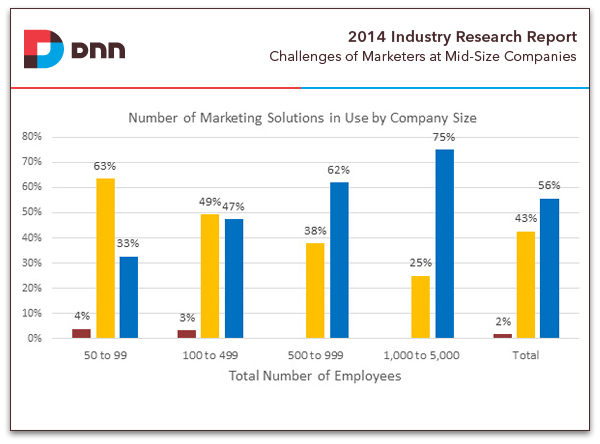
DNN’s “Marketing Got Complicated” report revealed that the
majority of marketers in mid-sized companies are juggling five or more
marketing solutions. The panelists’ advice was to find one platform, make sure
it’s the right choice, get to know it well, and build up from there.
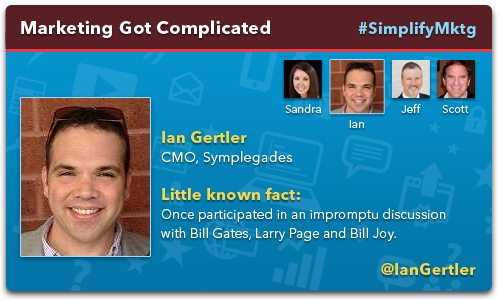
“Technology is supposed to be empowering, and it certainly has
been that in a lot of ways,”
Gertler said. But “it’s very important to not just
collect data, which a lot of people do, but to collect it, analyse it, and then
actually apply it back into the [marketing] equation.” That way, the right
marketing solution helps
guide business
decisions and shape customer experiences.
Scott Wilder, Global Nation Builder at Marketo, encouraged
participants to talk to marketers in similar-sized companies that aren’t
competitors, and ask about the budgets and internal resources they need to work
with different products.
Korhan suggested a “list
and limit” approach in which companies inventory the tools and resources
they’re using, keep the ones that best serve their objectives, and “forget
everything else until you master those.”
Zoratti agreed that marketers need “solutions that are a fit for
you, versus ones that boil the ocean,” and urged participants to
test-drive new solutions before
committing to them.
3) Marketing
Priorities: Harnessing the Tornado
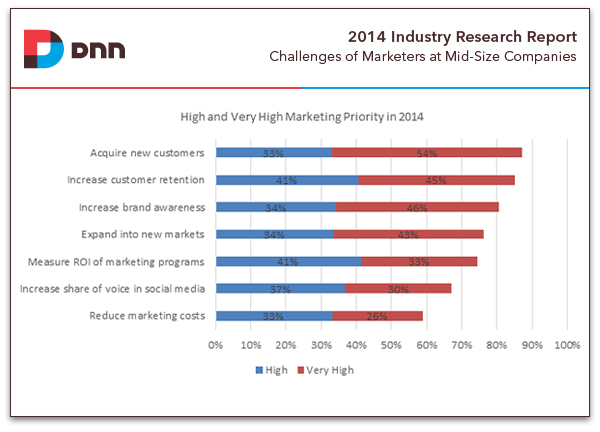
Shiao pointed to the large number of marketing objectives that had
received a high or very high rating from at least three-quarters of survey
respondents. “When you have so many priorities as a marketer, you essentially
have no priorities,” he said.
Zoratti agreed that “in the tornado that is marketing today, it’s
becoming really, really difficult” for companies to set a course and stick to
it, but she added a priority to the list: in addition to customer acquisition
and retention, increased brand awareness, new market development, and ROI
measurement, she stressed the
opportunity
to reactivate customers
who defect from a brand.
Marketers must “learn to say no so you can make room for yes,” she
said, and adopt an agile, flexible marketing approach that “allows them to be
nimble and use speed as a competitive advantage.”
Wilder said marketers should take a step back from multiple
tactical goals and keep an eye on a single corporate objective. “Focus on one
specific thing in terms of your goal and how you want to be evaluated, and
start there,” he recommended.
4) Online
Communities: Business Has Always Been Social
With 90% of survey respondents reporting that they had introduced
their own
online communities, or planned to by the end of 2015, Shiao asked
what steps companies should take before launching.
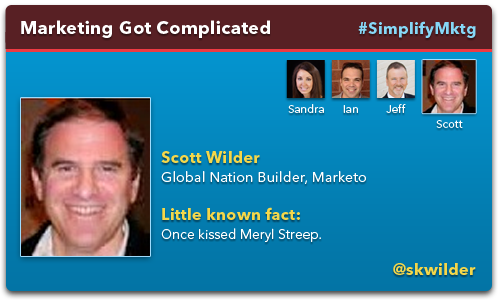
Wilder said marketers should make sure they can count on enough
participants to make a vibrant community, and understand what the
different people in an ecosystem, from
prospects, to customers in different verticals, to strategic partners, to
product champions -- can bring to the discussion. If an online community isn’t the
right answer, he added, “there are other ways to get users to collaborate
together.”
Gertler said social networks have finally moved online technology
away from a self-service mentality. “Business
has always been social,” he said. Online communities are “finally
reinforcing interaction and people connecting with one another again,” thereby “becoming
the heartbeat of how each business connects with its customer base.”
Korhan said marketers must always give online communities their
absolute best and strive to personalize the experience for members of different
communities and tribes. “People in those communities will be very active,” he
said, and that should trigger marketers to “invite them in to be major
contributors” to building the brand and attracting other community members like
them.
5) People,
Not Account Numbers
Shiao said marketers in mid-sized companies “might feel like
they’re the underdogs,” competing against organizations with bigger teams and
budgets. Wilder responded that “we all need to start thinking about
customers as people, and not account
numbers. The more we do that, the more they’ll want to interact and speak
with us.”
Gertler said mid-sized organizations can differentiate themselves
by understanding and delivering what customers need. “Value is such an
important thing, and the other part is relevance,” he said. “If something isn’t
relevant to what people need, you lose them right away.”
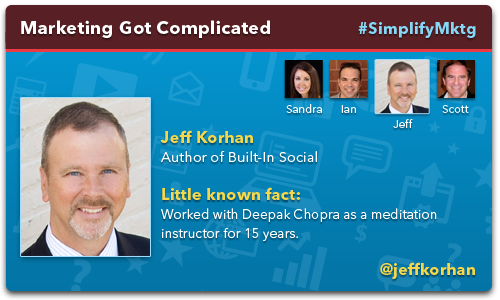
Korhan agreed that personalized service is a great way for smaller
companies to beat national brands. In his own past work as a landscape
architect, “we built up that trust level. We gave more personal attention. We
collaborated with the customers and really helped them understand possibilities
that they didn’t know.”

5 Incredibly Valuable Ways Marketers Can Use Branded, Online Communities
By Marisa Peacock
Zoratti said smaller organizations can benefit from internal and
external collaboration, “so you can solve challenges with an extended team of
resources.”
Conclusion
If you missed DNN’s live broadcast, you can still
register
to view the on-demand replay. In addition, DNN published the webinar
slides, which are included below.